Mouth Guards: Self-Defense For Your Teeth: Part 2– Custom & Speciality
Mouth Guards
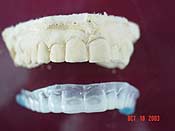
By Lenny Sclafani, DDS Editor’s Note: This is the second
of a two part article on mouth guards. Part
1 discussed off-the-shelf
options. Part 2 discusses custom dentist-made guards as well as options
for those wearing braces.
While off-the-shelf stock guards will protect your teeth from trauma
and blows, an even better option is a custom mouth guard that your dentist
can make for you. These custom guards, however, are much more expensive.
Costs range from $250.00 to around $500.00.
Custom mouth guards provide the best retention and will be the most
comfortable because they are custom molded to the exact form and shape
of your teeth. Once on, they also tend to stay on and not fall out like
the stock models tend to do.
Two brand names for these custom mouth guards are "Pro-form" and "OIS
Orthodontic." The latter comes with a $100 PER TOOTH INJURY WARRANTY,
if that's worth anything to you. :-) The Pro-form material has a brace
that can be incorporated behind the front teeth for added protection.
Because these are both made and fitted to your mouth by a dentist, you'll
also pay a bit more for these than for the store product; it depends
on how much you want to invest.
Most dentists or orthodontists can make these custom guards for you,
or at least take an impression and send the impression out to have the
guard made. First a mold of your teeth has to be made. A rounded tray-like
mold is filled with paste and pressed around each set of your teeth.
This is allowed to set (becomes rubbery) and then is removed (this is
called an alginate impression). This mold is then filled with plaster
to make a duplicate of your teeth from which the mouth guard is molded
(see below).
You also usually have a choice of mouth guard colors. A variety of multicolor
models also are also available, but a word of caution. Multicolor models
look cool outside the mouth, but when worn others see your teeth as a
mix of different colors, as if looking into the mouth of someone with
missing and broken teeth – not cool for those trying to impress
the opposite sex. One karate-ka, however, told me that he finds this
can initially disturb his opponents (an intimidation tactic), so he likes
it (see lead photo in Part 1).
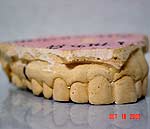 |
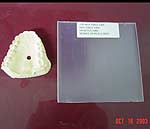 |
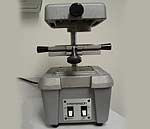 |
A stone (plaster) model of a patient's mouth trimmed so a custom
mouth guard can be made. |
The model and a sheet of thick .015 mouth guard tray material.
The model is perforated in the mid palate to allow better adaptation
of the softened tray material later on in the procedure. |
The "Pro-Form Vacuum Forming" Machine. Top portion is
a hood with heating coils to soften the tray material. Middle portion
is the frame which holds the tray material to be softened. This is
movable and can be lowered to the bottom platform. The Vacuum Pump
is located in the Base under the lower platform which will draw (or "suck
down") the softened tray material onto the model. |
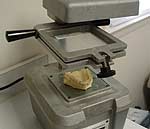 |
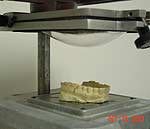 |
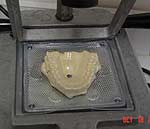 |
The Pro-Form Machine with the patient's model in place and the
sheet of .015 mouth guard material. |
The tray material has sagged about an inch. Notice the glowing
red heating coils on the upper element of the machine. The vacuum
switch is turned on and the frame with the softened tray material
is ready to be lowered onto the stone model. |
The tray material has been "sucked down" onto the stone
model and is very nicely adapted to the patient's "mouth." |
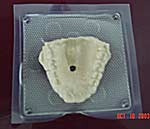 |
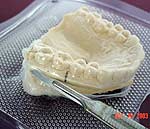 |
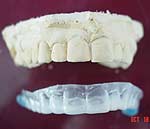 |
The tray material and model removed from the machine. |
Excess material is trimmed away with a sharpened
blade. "A
thousand and one uses for a scalpel." |
The completed Custom Mouth guard ready to get punched. |
(Photos compliments of Dr. Chris O'Hea,
an orthodontist and friend of the author)
If you press me for an opinion, I'd say to try the off-the-rack store
brand first. The investment is minimal and if it serves your purposes,
then you're "in." However, if you've already blocked a few
punches with your mouth and in the process have managed to lose a few
teeth, then you might want to try the professional route. Kinda like
20/20 hindsight.
Oh, one other thing, if you opt for the professionally made version,
you should tell your dentist what type of activity you are doing, so
that he can choose the appropriate thickness of tray material. Karate,
boxing, and football mouthpieces should be made of a heavier gauge material
than say soccer or field hockey. Most dentists usually stock these materials
since we see enough children all day long, and just about all of these
kids are playing some kind of contact sport these days.
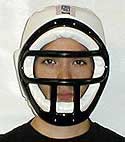 If you want additional insurance, your mouth guard protection can be
enhanced through wearing a head protector with face protection. There
are quite a few choices. Some have a clear plastic visor, while others
have either plastic bars running across the face or use a heavy wire
mesh. While face protection can help protect from a direct blow to the
teeth, they are less help against injury to teeth from hits to the jaw
which can drive one set of teeth upward into the other. Thus, mouth guards
should always be worn. If you want additional insurance, your mouth guard protection can be
enhanced through wearing a head protector with face protection. There
are quite a few choices. Some have a clear plastic visor, while others
have either plastic bars running across the face or use a heavy wire
mesh. While face protection can help protect from a direct blow to the
teeth, they are less help against injury to teeth from hits to the jaw
which can drive one set of teeth upward into the other. Thus, mouth guards
should always be worn.
What To Do If You Wear Orthodontics
Let’s talk a minute about students who are wearing braces. With
the topic of orthodontics, the question arises, "what do I do if
I am in full orthodontic wires and brackets, and my mouth looks like
the power grid of my local Con Ed (a New York electric provider) generating
station complete with rubber bands between the top and bottom teeth?"
The brackets themselves can cause some horrendous damage (though it
is only temporary) to the thin tissue lining of the lips and cheeks should
they get caught around the prongs of the brackets. I can speak from personal
experience on this one; believe me, it is not worth it!
For this situation we need to compromise a bit because a custom fit
mouth guard, like the one described above, will not fit over conventional
brackets and arch wires. I also do not know of an over-the-counter mouthpiece
specifically designed for kids with braces.
However, all is not lost since these things do indeed exist but as far
as I know they are only available professionally. Again, your friendly
neighborhood orthodontist should be able to get you one if he doesn't
keep them stocked in the office. All the specialists in my town keep
these things stocked because the demand is so high. I'd figure this to
be more the rule rather than the exception. He may just give you one
for the asking since they are pretty cheap. ($25/pkg of 10) But you didn't
hear this from me!
The orthodontic variety is of the double arch form and there is a "free
flow air channel" between the arches for easy breathing, so they
claim. Since they don’t mold to your teeth, these models aren’t
perfect, but the do provide some level of protection of your investment
(your orthodontics).
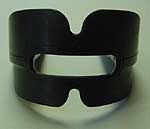 |
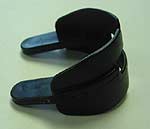 |
Two views of a special mouth guard made especially
for those wearing braces: available from your local orthodontist. |
So, the bottom line becomes, "If you have a $5 mouth then buy a
$5 mouth piece." If you want the most protection, or if your mother
is a feisty Italian mama, then the custom made heavy gauge material may
be the overall best bet for your health (remember, Mom may kill you)
and continued good looks. For ultimate protection wear protective headgear
with a face mask.
Mouth Guard Care
Keep your mouth guard clean. Rinse it after use in cool water and occasionally
clean it with cool soapy water and then rinse it well.
Store your mouth guard in something enclosed to keep it clean. A ventilated
sturdy container is best, but a plastic bag is better than nothing at
all.
Avoid leaving your mouth guard in a closed hot automobile, in direct
sunlight or in any place that it might be subjected to heat (which can
deform the guard).
Don’t use or handle someone else’s mouth guard.
Disclaimer: The opinions expressed in this article are exclusively those
of the author. Students and practitioners of various arts or sports should
talk to their own dentists or orthodontists for their opinion as to which
type of mouth guard to wear. The author has tried to be inclusive as
much as possible, but some brands or kinds of mouth guards may be been
inadvertently excluded.
About The Author Lenny Sclafani, DDS is
a dentist in private practice since 1979. He works and lives in Parsippany,
NJ with his wife, Monica, and daughters Katie, age 12, and Jenny, age
10. He has be training in Isshinryu Karate since 1971 and Matayoshi Kobudo
since 1995. He may be reached via email at: toothaik@optonline.ne
|